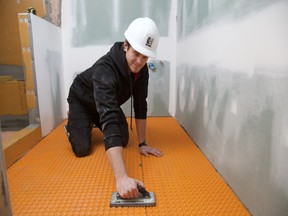
Reviews and recommendations are unbiased and products are independently selected. Postmedia may earn an affiliate commission from purchases made through links on this page.
In-floor heating can be a great addition to your home and it seems to be all the rage recently. It can be installed in almost any room and is most common in laundry rooms, mud rooms and entranceways, “wet zones” or cold floor zones.
Let’s review the basics. There are two types of underfloor heating systems — electric and water-based systems.
Sign up to receive the daily top stories from the National Post, a division of Postmedia Network Inc.
Thanks for signing up!
A welcome email is on its way. If you don't see it, please check your junk folder.
The next issue of NP Posted will soon be in your inbox.
Water-based systems circulate water from a boiler or water heater through polyethylene tubing (PEX piping), beneath the finished floor. In contrast, electric warming systems use coated cables and heated wires under the floor.
Hydronic heat systems can take the place of other central heating systems and often act as the primary heat source for the entire home, while electric systems are typically made to heat the floor in a selected location.
Radiant in-floor heating is an efficient method of delivering heat and is usually more efficient than forced-air heating because it eliminates duct losses. Forced-air heat tends to be the warmest near the source and cools or dissipates as you move further from the source. In contrast, radiant heat provides consistent heat throughout the space, and your feet always feel warm and toasty.
Electric in-floor heating systems use cables and heated wires coiled in a mat or within the decoupling membrane installed below tile flooring. I don’t recommend installing electric wires without a decoupling membrane. My crew and I only use electric in-floor warming systems with an uncoupling membrane. It offers waterproof and vapour barrier properties when properly installed, ideal for wet zones like bathrooms, kitchens, entranceways, mud rooms and laundry rooms. I always use an orange membrane that comes installed with dimples that allow you to click in the wiring easily and lets you adjust for going around toilets and fixtures. I recently tried out the new “peel and stick” version of this product, which helped speed up the installation and required less labour, so I loved that innovation.
Electric radiant heat is less expensive to install than a hydronic system; once the temperature is set, it warms up quickly and operates quietly compared to forced air-supplied heat.
An uncoupling membrane also prevents movement and stress in the subfloor from transferring to the tile or stone floor above, preventing your tiles or grout from cracking. However, almost any type of flooring can be used with in-floor heating.
Ceramic, porcelain, or natural stone tiles are all excellent temperature conductors. Engineered wood, vinyl and laminate have temperature limitations that can cause warping if exceeded, so do your research before choosing your flooring and consult a flooring expert.
An electric in-floor warming system works great with a programmable thermostat providing convenience and control of your in-floor heating from your mobile phone.
Avoid placing large pieces of furniture, like mattresses or area rugs directly on the floor as heat can get trapped, decreasing the system’s effectiveness and potentially damaging the floor. Ensure there is at least two inches (5 cm), of clearance, allowing the heat to radiate evenly.
An electrician should perform the installation for electric in-floor heating or a certified heating contractor with a gas fitter’s licence for hydronic systems. Electrical in-floor heating systems are wired and connected to the circuits in your home’s electrical panel as per the manufacturer’s recommendations. Although a contractor or a homeowner can install heating elements or panels, a licensed electrical contractor should complete the electrical connection.
Licensed heating contractors must install radiant hydronic floor heating. The best value for this heating system is when it is used as the primary heat source for the entire home and not just for bathrooms or entranceways. Hydronic systems are more costly to install since they require liquid distribution pipes, a heat source (such as a water heater or boiler), possible transfer plates, and engineering.
Electric radiant heating systems typically don’t require continuous upkeep or repair. However, a hydronic heating system should have an annual maintenance checkup by a heating technician, which includes checking for leaks, ensuring the manifold is balanced and the design pressure is maintained.
Make sure you are using products, like a decoupling membrane, that maintain a complete warranty on the installation. You may think you are saving money by combining items from various manufacturers or suppliers, but you should check that the installation complies with the warranty requirements.
Electric in-floor warming systems bring a touch of luxury and comfort, can increase real estate value, provide an even distribution of heat, and work with many flooring materials. Electric in-floor heating is a great option if you are renovating your bathroom or a space that needs supplemental heating.
Residents of the GTA can apply for Season 2 of Holmes Family Rescue at www.makeitright.ca


